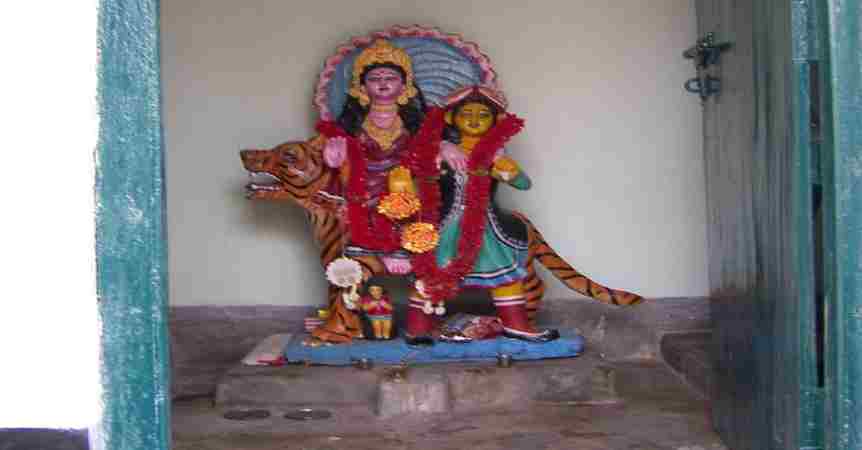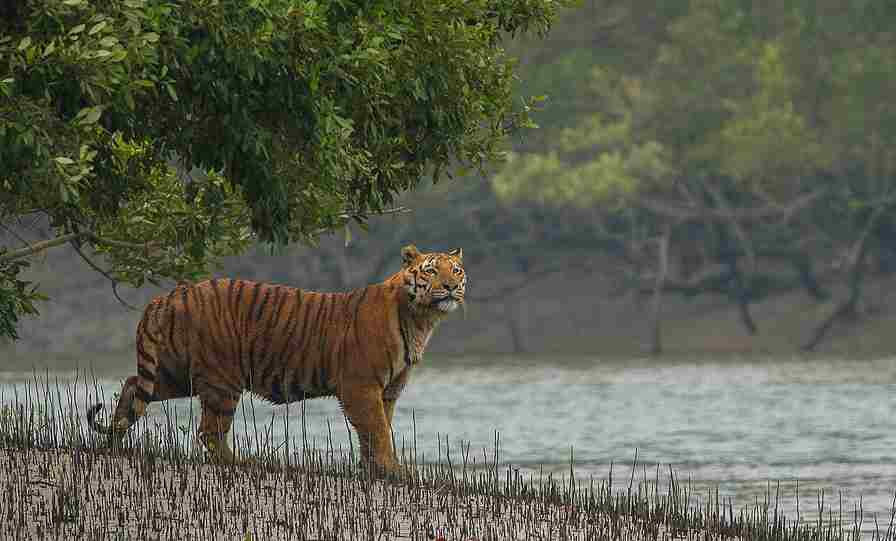
Bonbibi
- Bonbibi, the lady of the forest also known as the guardian spirit of the forest. People of Sundarbans gave different names to their goddess Banbibi such as Bandevi, Bandurga, and Byaghradevi. She is mostly prayed to by the honey collectors and woodcutters to save them from the attacks of tigers. It is believed that a demon king named Dakhin Rai, an arch-enemy of Bonbibi appears as a tiger and attacks human beings. Forest god Bonbibi is worshipped by both Hindu and Muslim residents of the Sundarbans.
Literature:-
We can find stories about Bonbibi in several texts named Banbibir keramati (The magical deeds of Bonbibi), or Banbibir jahuranama (glory of Bonbibi. Bayanuddin and Munshi Mohammad Khater mentioned Bonbibi and her stories in their Bengali verse known as Dwipodi poyar (the two-footed line). They described the battle between Dakhin Rai and the narrative of Dukhe, published at the end of the 19th century by a Muslim author Munshi Mohammad Khater of Govindapur. Khater reveals that this is not his invention and he set it into a verse at the request of the people. It is written in Dobhasi Bangla, a variety of language used by Muslim religious literature, and contains several Urdu and Arabic elements.
Amitav Ghosh also mentioned Bonbibi in his book ‘The Hungry Tide’.
Tales of Bonbibi:-
- According to mythology, Bonbibi is believed to be the daughter of Ibrahim a fakir from mecca. As Ibrahim’s first wife cannot get pregnant, he married Golalbibi for the second time but to keep the promise of the first wife Ibrahim left her pregnant Golalbibi in the forest. Golalbibi then gave birth to two children whom she called Bonbibi and Shah Jangali. Golalbibi abandoned Bonbibi as she is not able to rise both the children. Bonbibi was raised by a deer and grew up. Later the family got united in the medina. Holy woman Fatima granted Bonbibi the possibility of saving forest people whenever they need. By and Shah Jangali returned to India where they became the lord of swampland inhabited by a demon, Dakhin Rai and his mother Narayani. However, Bonbibi showed her generosity and decided that she would rule only half the land, leaving the rest to the demon.
Symbolic Representation Of Bonbibi:-

Bonbibi’s Hindu image is found as wearing a sari, a crown, and garland, carrying a club, and Trishul and her vahana (vehicle) is a tiger.
Bonbibi’s Muslim image is found with braided hair, wearing a cap with a tikli. She wears ghagra, pajama and a pair of shoes.
Both Hindu and Muslim images have a boy in her lap believed Dukhe by her worshippers. Her Vahana is a tiger or a hen.
Geographical Structure Of Sundarban
Sundarban is a mangrove area in the delta formed by the confluence of Padma, Brahmaputra, and Meghna River in the Bay of Bengal. It spans the area from Baleswar River in Bangladesh’s division of Khulna to Hooghly River in India’s state of West Bengal. It comprises closed and open mangrove forests, land used for agricultural purposes, mud flats, and barren land, and is intersected by multiple tidal streams and channels. Four protected areas in the Sundarban such as Sundarban west (Bangladesh), Sundarban East (Bangladesh), Sundarban south (Bangladesh), and Sundarban National Park (India) are enlisted as UNESCO world heritage sites. Sundarbans are considered endangered in a 2020 assessment under the IUCN RED LIST of ecosystem framework. The Sundarbans mangrove forest covers an area of about 10,000km^2 (3,900 sq mi) of which forests in Bangladesh’s Khulna Division extend over 6,017km^2 (2,323 sq mi) and in West Bengal, they extend over 4,260 km^2 (1,640 sq mi) across the South 24 Parganas and North 24 Parganas district. The Indian part is occupied by water bodies in the forms of rivers, canals, and creeks of width varying from a few meters to several kilometers. In Sundarban there is a ban on all killing or capturing of wildlife other than fish and some invertebrates, it appears that there is depleted biodiversity or loss of species. The government started many preservations plans to protect Sundarban but there is a constant depletion because of natural and human-made causes.
The history of human settlement in the Sundarban area can be traced back to the Mauryan era (4th-2nd century BCE). The Sundarban is intersected by a complex network of tidal waterways, mudflats, and small islands of salt-tolerant mangrove forests. The interconnected network of waterways makes almost every corner of the forest accessible by boat. Mangrove acts as a biological shield of Sundarban from soil erosion, tsunami, and cyclone. The forest provides habitat to 453 fauna wildlife including 290 birds, 120 fish, 42 mammals, 35 reptiles, and eight amphibian species. The area is known for the Bengal tiger but other numerous faunas are present including birds, spotted deer, crocodiles, and snakes. Rivers in Sundarban are meeting places of salt water and fresh water. Thus, it is a region of transition between the freshwater of the river originating from the Gang a and the saline water of the Bay of Bengal.
1. Climate Of Sundarban:-
- The climate in Sundarban is generally soothing and pleasant. Ordinarily, the climate in Sundarban ranges from 34°c to 20°c, and the rainfall is extremely high so the weather is almost always moist and with the humid air from the Bay of Bengal blowing constantly carrying 80% humidity. The area of the world that regularly experience major tropical cyclones threatening the habitats of many species and human existence.
2. Soil Of Sundarban:-
- The Sundarban reserve forest comprises mainly saline alluvial soil consisting of clay, alluvial soil, fine sand, and coarse sand particles. Sundarban is also called a vanishing Island because the watery landscape of Sundarbans comprises islands that are disappearing owing to rising tides.
3. Ecosystem:-

- Sundarban is the largest mangrove ecosystem in the world named after the dominant mangrove tree species Heritiera fomes, known as Sundari in Bengali. 28 species of major mangroves have been found in India Sundarban. 334 plant species belonging to 245 genera and 75 families, 165 algae, and 13 orchid species. The Sundarban freshwater swamp forest is a tropical moist broadleaf forest. Mangrove is important because it is known to be among the most effective natural barriers against flooding. The Sundari is the dominant mangrove tree species of Sundarban of India and Bangladesh. The Sundari or Heritiera fomes is a species of mangrove in the family Malvaceae. The Sundari trees can grow up to 60feet in height with a girth of six feet.
4. Flora:-
- The Sundarban flora is characterized by the abundance of Sundari ( Heritieria Fomes), Gewa(Excoecaria Agallocha), Goran (Ceriops Decandra), and Keora( Sonneration Apetala) all of which occurs prominently throughout the area. Avicennia, Xylocarpus mekongensis, Xylocarpus granatum, Sonneratia apetala, Ceriops decandra, Aegiceras corniculatum, Rhizophora Micronata, and Nypa fruticans are the other trees found in Sundarban.
5. Fauna:-

Tiger, leopards, Rhinoceros, Wild buffaloes, Wild Hogs, Wild cats, Barasinga, Spotted Deer, Hog Deer, Barking Deer, and monkeys are the wild animals found in Sundarban.
The endangered species that live in Sundarban’s are ROYAL BENGAL TIGER, Saltwater crocodile, river terrapin, olive ridley turtle, mangrove horseshoe crab, fishing cat, and Rhesus monkey. In the 2014 National census, 76 tigers were traced in the zone. In 2018 the number of big cats was 88. The date from 2020 to 2021 census conducted by the state forest department found 96 tigers in the delta.
To protect the Royal Bengal Tiger project Tiger was started. Project tiger is a tiger conservation program launched in 1873 by the Government of India. The project aims to sage guard the viable population of Bengal tigers in their natural habitat.
6. Birds In Sundarban:-

There are about 248 bird species found in Sundarban National Park including a large number of migratory birds from higher latitudes that visit the park in the winter months Horton’s, Egrets, Cormorants, Storks, Green pigeons, sandpipers, large and small spoonbills, darter, seagulls, teal, partridges, great variety of wild geese and ducks are also found here.
The main species of birds in Sundarban National Park are Black Hooded oriole, mangrove whistler, cinnamon Bittern, and swamp francolin.
7. Fish:-
- The population of fish is declining because of human activities which bring climate change. Indian Sundarban area has around 172 species of fish, 20 species of prawn, and 44 species of crab are there. There are five edible varieties for local consumption and supply to Kolkata. These are Bhetki (Lates calcarifer), Nona Tangra (mystusgulio) sona tangra (Mystus tangra), chital (Notopterus chitala), and Falui (Notopterus homopterous).
Economy Of Sundarban
In Sundarban there are basically six major economic groups of the population. Agriculturist, captive breeder of fish, fisherman, and collectors of fish, collector of honey, collector of timber and fuel wood, collector of non-timber minor forest products.
Agriculture is the main occupation in the Sundarban region. In spite of the high salinity level of water, about 85% of the population depends on agriculture. The yield of winter rice (main crop) has remained at between 1.0. – 1.5 tons per hector for many years. Multiple cropping is rare in the Sundarban area. Due to fewer irrigation facilities, most of the lands are mono-cropped and mostly devoted to Kharif paddy cultivation.
Fish is the second most important part of Sundarban after agriculture. A large area of the western Sundarban consists of a water body with beautiful estuarine fisheries comprising of large canals, rivers, and estuarine small canals. In Sundarban the availability of fish in the natural water may be classified into three types, marine species (Hilda, Topse, etc), sweet water species (p. monodon, etc), and marine fishes (gujari, chanpra prawn, etc). In the saltwater of Sundarbans 130species of fish prawns and crabs are available. Fishing activities continue throughout the year, production starts increasing from the onset of monsoon and reaches its peak during winter (November-January) at 81.9% of total fish catch. Traditional fishermen operate in the major rivers like Matla, Bidyadhari, Thakuran, and their innumerable tributaries. Fisherman catches Khaira, Bhola, Topse, and other fishes. Extremely poor people hunt fish which are found in the innumerable creeks with tidal water. The brakish water is famous as Nona-Bheri. The owner of these bheris are mostly rich traders-man. Every year from October to mid-November, water from this bheris, adjacent to the river is drained out completely. At the end of November, they are refilled with water from the rivers that bring in a wide variety of fishes like Bhetki, Parse, Bhangar, and Banda. These fishes are netted in the months between January and July. Rubi, Katla, shoal, kai, and some varieties of sweet water fishes are cultivated in the tanks. Poor and marginal farmers particularly from Canning, Namkhana, Gosaba, and Hingalganj depend on this source. Winter migratory Bag-net fishery is the main concentration of the group which is on Safar Island at the estuary mouth and the other around Frasergunj, Bakkhali, Kalisthan, and Jamboodwip island. It takes place from the end of October to early February. The crab market witnessed rapid growth over the past decades. Crab catching is an important supplementary activity for the fisherman in Sundarban.
Commercial coastal fishing generates over– exploitation of commercially valuable aquatic species like prawn, crab, prawn seedling, etc. A large section of the poor tidal population especially women and children were engaged in the fishing and collection of tiger prawn (Penaeus monodon) during daily tides.
Timber and fuel wood collection from the mangrove forest area of Sundarban is a very traditional economic activity. The recent restriction was imposed on the cutting of Sundari, Passur, Dhundul, and Kankra. The restriction has also been imposed on keora.
Bee-keeping is making popularized in the Sundarban Biosphere Reserve. In some blocks of Sundarban, these beekeeping activities are the source of honey and indirectly source of earning.
Honey and wax collection in the Sundarban are one of the major seasonal activities. In Sundarban one among the four species Dorsata (Rock bee) migrates between March and June every year from the Himalayas it gives 80% of the total honey production in India. Genwa branches are ideal for comb formation. In Sundarbans, Honey collectors are referred to as Modules. Honey is produced and collected in the first phase between March and May.
- Education- In 2011, the literacy rate of the people in Sundarbans was 25.7 percent compared to West Bengal’s 76.26 percent several organizations are dedicating themselves to innovative efforts to improve education in Sundarban.
Environmental Degradation
Climate Change- Lying in the low coastal zone makes the Sundarbans more vulnerable to the effects of the changing climate and causes a flood, cyclones, relative sea level rise, and coastal erosion. According to the studies, there will be an increase in salinity and higher tidal surges, and permanent submergence of land mass.
The exploitation of natural resources- Sundarban is home to many people who lack infrastructure, health care, education, and transport, as well as restricted livelihood options communities, struggle to meet their basic needs. People mainly depend on forests for their living. A majority of the population depends on fuel wood for thermal energy, as biomass in the village is inadequate to meet their energy needs. They are also dependent on other forest needs such as fish and crab. The biotic pressure and unsustainable exploitation of forest resources lead to the degradation of natural habitats resulting in the loss of biodiversity.
Human-Wildlife Conflicts- The human population depends on biodiversity resources for their livelihood. They are exposed to a unique set of biotic hazards, ranging from snake bites to tiger attacks.
Top 13 Interesting Facts About Sundarban
Sundarban is 10 times bigger than Venice.
Sundarban forest on the Indian side has 102 islands out of which 54 islands are inhabited and the rest of the area is covered with forest.
Gosaba (13ft from sea level) is the biggest and last inhabited island on Sundarban.
Sundarban has a unique tidal phenomenon that takes place twice a day.
Phytoplanktons is the small microorganism that reflects light in the dark new moon in Sundarban.
Cyclone Sidr (2007), Amphan (2019), and Aila (2007) damaged Sundarbans. The high tide impacted the agricultural lands of Sundarbans with salty water which took almost 2-3 years for the villagers to practice agriculture again.
In 1878 the Sundarbans Forest was notified as a ‘protected Forest’ by the British administration under the Forest Act, 1865 (Act viii of 1865).
Biplab Das a Sundarbans native with an MBA founded the kishalay foundation (sabuj sangha). The kishalay foundation focuses on the improvement of education for the Sundarban underprivileged children affiliated with the West Bengal Government.
Golpata and Hental which were collected by villagers stopped in 1978 and in 1991 respectively.
Lohachara island, new Moore Island south talpatti island have disappeared under the sea, and ghoramara island is half submerged.
A Bee-keepers co-operative society limited, Shasan Baruipur, south 24 Parganas was established for the better management of bee-keeping.
The endangered species that live in Sundarban and the extinct species that used to live in Sundarban are Bengal tiger, estuarine crocodile, northern river terrapin, olive ridley sea turtle, Gangetic dolphin, king crabs, ground turtle, hawksbill sea turtle.
To stay in Sundarban one has to take permission from forest range officers.






